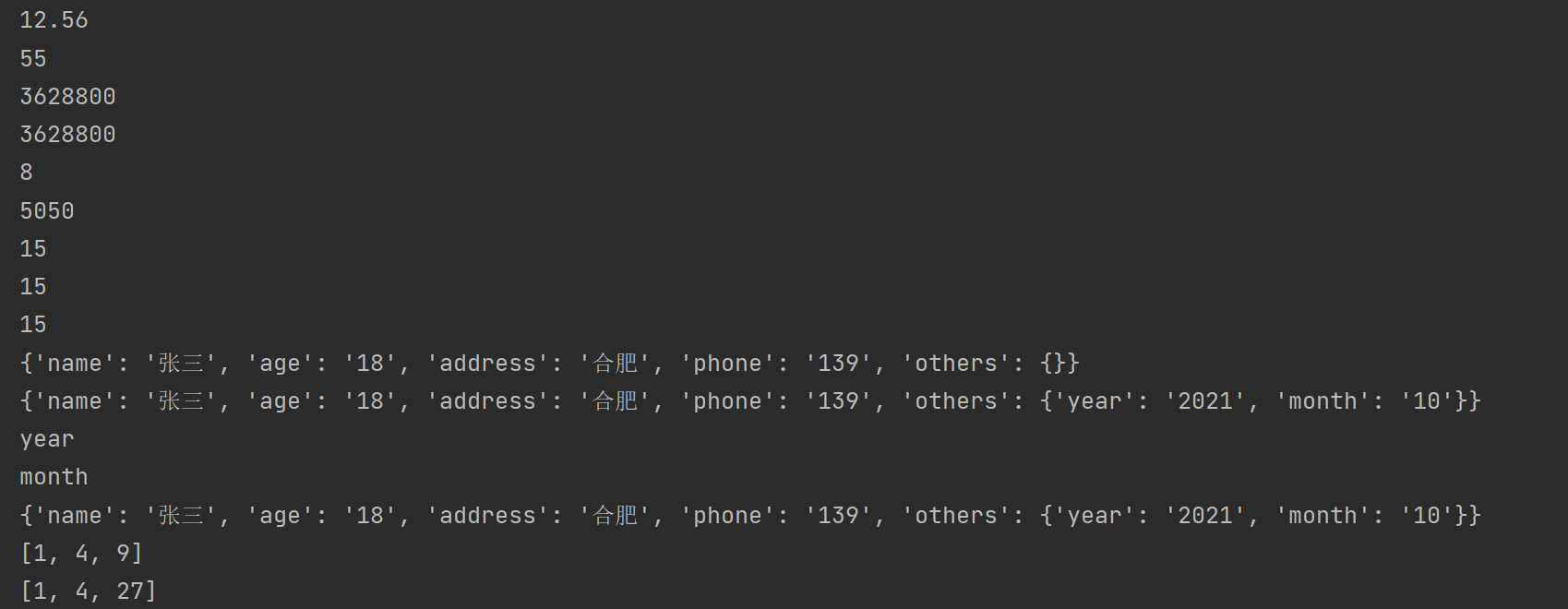Python语法2
选择结构
if,elif,else,使用时注意条件的先后顺序
通过缩进四个空格来区分代码块
# 从控制台输入
age = int(input("请输入一个年龄"))
if age >= 18:
print("成年")
elif age < 0:
print("输入错误")
else:
print("未成年")
循环结构
for,whil,如果做循环一般使用while,for循环一般用于遍历
# 计算1-100和的值
i = 0
cum = 0
while i < 100:
i += 1
# 在Python没有++,--方法
cum += i
print(cum)
# 计算10的阶乘
cum = 1
i = 1
while i < 10:
cum = cum * i
i = i + 1
print(cum)
# 直接遍历字典只能获取key
dict1 = {"k1": "v1", "k2": "v2", "k3": "v3"}
for key in dict1:
print(key)
# 获取value
for key in dict1:
print(key, dict1.get(key))
# 使用items方法,返回二元组类型
for i in dict1.items():
print(i, type(i))
# 用两个变量进行接收二元组
for i, j in dict1.items():
print(i, j)
5050
362880
k1
k2
k3
k1 v1
k2 v2
k3 v3
('k1', 'v1') <class 'tuple'>
('k2', 'v2') <class 'tuple'>
('k3', 'v3') <class 'tuple'>
k1 v1
k2 v2
k3 v3
文件读写
# 读文件
f1 = open("data/data1", mode="r", encoding="utf8")
# mode="r", encoding="utf8"也可以省略
print(f1.read(10)) # 读取指定字符个数
print(f1.readline()) # 读取一行
print(f1.readlines()) # 读取所有行,并以list存储
f1.close()
# 写文件
f2 = open("data/write1", mode="w")
# w表示写文件覆盖写,a表示追加写
# write只能写string
f2.write("1\n")
# writelines可以写列表
f2.writelines(["1", "2", "3"])
f2.close()
# 读写文件
# 每次读写都需要close关闭,所以可以用with open,可以自动关闭
with open("data/data1") as f1:
with open("data/write2", mode="w") as f2:
f2.writelines(f1.readlines())
D:\ALanzhishujia\soft\python\python.exe C:/Users/19768/PycharmProjects/PythonLearning/demo3.py
Beautiful
is better than ugly.
['Explicit is better than implicit.\n', 'Simple is better than complex.\n', 'Complex is better than complicated.\n', 'Flat is better than nested.\n', 'Sparse is better than dense.\n', 'Readability counts.\n', "Special cases aren't special enough to break the rules.\n", 'Although practicality beats purity.\n', 'Errors should never pass silently.\n', 'Unless explicitly silenced.\n', 'In the face of ambiguity, refuse the temptation to guess.\n', 'There should be one-- and preferably only one --obvious way to do it.\n', "Although that way may not be obvious at first unless you're Dutch.\n", 'Now is better than never.\n', 'Although never is often better than *right* now.\n', "If the implementation is hard to explain, it's a bad idea.\n", 'If the implementation is easy to explain, it may be a good idea.\n', "Namespaces are one honking great idea -- let's do more of those!\n"]


函数
# 计算圆的面积
def area_of_cycle(r):
pi = 3.14
print(pi * r * r)
area_of_cycle(2)
# 计算1-n的和
def sum_1_to_n(n):
cum = 0
i = 1
while i < n + 1:
cum = cum + i
i = i + 1
print(cum)
sum_1_to_n(10)
# 计算1-n的阶乘
def jieCheng(n):
i = 1
cum = 1
while i <= n:
cum = cum * i
i = i + 1
print(cum)
jieCheng(10)
# 递归实现阶乘
def recursion(n):
if n == 1:
return 1
return n * recursion(n - 1)
print(recursion(10))
# 计算x的n次方
def power(x, n):
print(x ** n)
power(2, 3)
# 传入大量的数求和,可以传入list中
list1 = [i for i in range(1, 101)]
def sum_nums_with_list(l):
cum = 0
for i in l:
cum += i
print(cum)
sum_nums_with_list(list1)
# 可变参数 *,可以不用list直接传入数
# args相当于一个list
def sum_nums_with_args(*args):
cum = 0
for i in args:
cum += i
print(cum)
sum_nums_with_args(1, 2, 3, 4, 5)
# 等价于
list2 = [1, 2, 3, 4, 5]
sum_nums_with_args(list2[0], list2[1], list2[2], list2[3], list2[4])
sum_nums_with_args(*list2)
# 关键字参数**
# **后的参数相当于传入的值进入一个字典
def regsiter(name, age, address, phone, **kw):
dict1 = {"name": name, "age": age, "address": address, "phone": phone, "others": kw}
print(dict1)
regsiter("张三", "18", "合肥", "139")
regsiter("张三", "18", "合肥", "139", year="2021", month="10")
# 命名关键字参数
# 检查传入参数是否有year,month
def regsiter2(name, age, address, phone, **kw):
if "year" in kw.keys():
print("year")
if "month" in kw.keys():
print("month")
dict1 = {"name": name, "age": age, "address": address, "phone": phone, "others": kw}
print(dict1)
regsiter2("张三", "18", "合肥", "139", year="2021", month="10")
# 匿名函数
# 对list中每一个元素进行平方
list3 = [1, 2, 3]
def func(x):
return x * x
print(list(map(func, list3)))
# 因为要写一个函数太过函索,所以可以使用lambda简化
print(list((map(lambda x: x ** x, list3))))
结果:

类和对象
类是对象抽象,对象时类的具体实现
三大特性:封装,继承,多态
# 定义一个Person类
# 封装:类里面封装属性,方法
class Person():
# 定义一个构造方法
# 类的属性需要定义在构造方法中
# 类中所有得方法第一个参数都是self,在调用时会自动转入
def __init__(self, id, name, age, gender):
self.id = id
self.name = name
self.age = age
self.gender = gender
# 这个属性不需要通过传参,直接写死
self.common = "我是猪"
# 如果某个属性不想公开,可以在属性之前加上__
self.__secret = "这是一个秘密"
# 定义方法
def run(self):
print("%s 跑的很快" % (self.name))
return 1
# 相当于java中的tostring
def __str__(self):
return "class Person(%d %s %d %s)" % (self.id, self.name, self.age, self.gender)
# 封装方法
def __test(self):
print("测试封装方法")
# 实例化 构造对象
person = Person(1001, "张三", 18, "男")
print(person)
print(person.name)
print(person.run())
# 调用封装的属性,通过 _类型__属性名 获取
print(person._Person__secret)
# 调用封装的方法
person._Person__test()
print("----------------------------------------------")
# 继承
class Teacher(Person):
def __init__(self, id, name, age, gender, subject):
# 直接得到父类的属性
super(Teacher, self).__init__(id, name, age, gender)
self.subject = subject
# 写个teach的方法
def teach(self):
print("%s教的%s很棒" % (self.name, self.subject))
# 重写Person的tostring方法
def __str__(self):
return "class Teacher:%d %s %d %s %s" % (self.id, self.name, self.age, self.gender, self.subject)
teacher = Teacher(1002, "张老师", 33, "女", "语文")
print(teacher)
print(teacher.name)
# 这里可以直接使用父类的方法
print(teacher.run())
print(teacher.teach())
print("---------------------------------")
# 多态
# 父类引用指向子类对象
def runTwice(c):
c.run()
c.run()
runTwice(person)
runTwice(teacher)
结果:

Python语法2的更多相关文章
- 对 Python 语法不够了解导致的 bug
对 Python 语法不够了解导致的 bug. `in` '20' in '11264,6144,4096,3072,2048,1024,300,30' Out[7]: True a_list = ' ...
- python 笔记2:python语法基础
python语法学习笔记: 1 输入输出 input(),print(). name = input('input your name : ')print('hello ,'+name)print(& ...
- python语法快速入门(1)
http://www.runoob.com/python/python-tutorial.html Python 是一种解释型语言: 这意味着开发过程中没有了编译这个环节.类似于PHP和Perl语言 ...
- python语法笔记(四)
1.对象的属性 python一切皆对象,每个对象都可能有多个属性.python的属性有一套统一的管理方案. 属性的__dict__系统 对象的属性可能来自于其类定义,叫做类属性:还可能 ...
- python语法-[with来自动释放对象]
python语法-[with来自动释放对象] http://www.cnblogs.com/itech/archive/2011/01/13/1934779.html 一 with python中的w ...
- wxpython 支持python语法高亮的自定义文本框控件的代码
在研发闲暇时间,把开发过程中比较重要的一些代码做个珍藏,下面的代码内容是关于wxpython 支持python语法高亮的自定义文本框控件的代码,应该是对大家也有用. import keywordimp ...
- Python语法的转义字符
Python语法的转义字符 转义字符 说 明 \ 续行符 \n 换行符 \0 空 \t 水平制表符,用于横向跳到下一制表位 \'' 双引号 \' 单引号 \\ 一个反斜杠 \f 换页 \0dd 八进 ...
- Python语法教程总结规范
Python语法易错点记录 本文提供全流程,中文翻译. Chinar 坚持将简单的生活方式,带给世人!(拥有更好的阅读体验 -- 高分辨率用户请根据需求调整网页缩放比例) Chinar -- 心分享. ...
- 初试Python语法小试牛刀之冒泡排序
Python很火,心里很慌,没吃过猪肉,也要见见猪走路. 看了几天Python的语法,大概初步了解了一点点,https://www.liaoxuefeng.com/wiki/0014316089557 ...
- (数据分析)第02章 Python语法基础,IPython和Jupyter Notebooks.md
第2章 Python语法基础,IPython和Jupyter Notebooks 当我在2011年和2012年写作本书的第一版时,可用的学习Python数据分析的资源很少.这部分上是一个鸡和蛋的问题: ...
随机推荐
- vue 双向绑定(v-model 双向绑定、.sync 双向绑定、.sync 传对象)
1. v-model实现自定义组件双向绑定 v-model其实是个语法糖,如果没按照相应的规范定义组件,直接写v-model是不会生效的.再说一遍,类似于v-on:click可以简写成@click,v ...
- 灵魂画手:漫画图解 SSH
OpenSSL 本身是一个软件库,这个软件被广泛的应用在系统服务器当中,他的主要功能是在网络通信的过程中,保证数据的一致性以及数据传输过程中的安全性.软件本身是由C语言编写,这使得他具备了跨平台的特性 ...
- Python - 面向对象编程 - 小实战(2)
需求 小明和小美都爱跑步 小明体重 75 公斤 小美体重 45 公斤 每次跑步会减肥 0.5 公斤 每次吃东西体重增加 1 公斤 需求分析 小明.小美都是一个具体的对象,他们都是人,所以应该抽象成人类 ...
- Abp VNext权限定义
在Shop.Application.Contracts项目中Permissions目录下ShopPermissions定义权限名 namespace Shop.Permissions { public ...
- 机器学*——K*邻算法(KNN)
1 前言 Kjin邻法(k-nearest neighbors,KNN)是一种基本的机器学*方法,采用类似"物以类聚,人以群分"的思想.比如,判断一个人的人品,只需观察他来往最密切 ...
- 对Java的annotation(注解)的认识
什么是java的annotation(注解) ? 注解的定义(annootation): public @interface TestAnnotation { } 上面的这种形式,便定义了注解是如何定 ...
- no rxtxSerial in java.library.path
java开发过程中,遇到no rxtxSerial in java.library.path问题,是由于缺少一个dll文件导致. 在jre/bin下添加rxtxSerial.dll 文件 win10环 ...
- 关于open falcon 与nightingale 的一些调研
针对 open-falcon 与 nightingale 的调研 一.open-falcon 1.1 组件介绍 1.1.1 agent > agent用于采集机器负载监控指标,比如cpu.idl ...
- 基于AM335X,如何搭建优良的Linux开发环境(下)
接着上一篇文章的Linux开发环境搭建,文章中详细讲解了 VMware14.1.1虚拟机安装.基于虚拟机安装Ubuntu14.04.3操作系统.安装Ubuntu14.04.3操作系统.安装虚拟机工具. ...
- P4389-付公主的背包【生成函数,多项式exp】
正题 题目链接:https://www.luogu.com.cn/problem/P4389 题目大意 \(n\)种物品,第\(i\)种大小为\(v_i\),数量无限.对于每个\(s\in[1,m]\ ...
